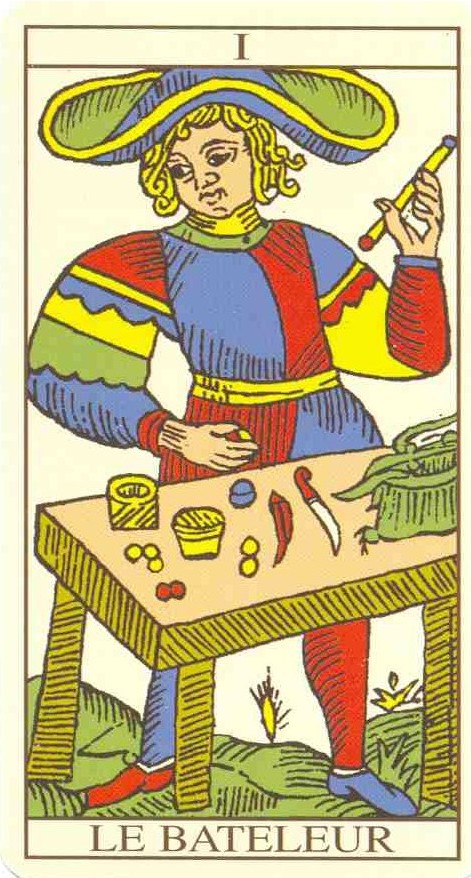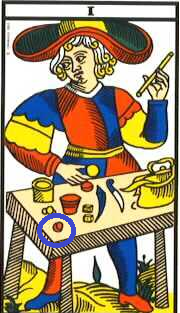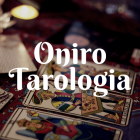The Magician Tarot card table symbolism
In this article we analyze the Magician table symbolism. The Magician is the first Major Arcanum of the Tarot deck and in his table we see a collection of different objects, which can be analyzed according to different perspectives.

First of all we find on the Magician table the four Tarot suids: knives or blades (swords), coins (pentacles), glasses and containers (cups). And the wands? This suit is in the hands of the Bateleur himself, in the form of a magic stick. The stick, as I explain in another article (read here!), is connected to the magical-irrational function of intuition.
From a psychological point of view, the suits of the Tarot are linked to the four psychological functions of Carl Gustav Jung. I talk about this in another article: “Tarot and psychological types“. In dreams, our “inferior” function often reappears in the form of an unwelcome character, like the Jungian Shadow.
The tools of the Magician Tarot card are also related to the four elements: sword = air; coins = earth; cups = water; wands = fire.
The Magician table and the instruments of the Passion of Christ
The most curious aspect, however, which to many eludes, is that on the Magician table (at least in the Tarot of Marseille) we also find the main symbols linked to the Passion of Christ:
- an awl, which resembles the crucifixion nail;
- a blade, like the tip of the Holy Lance with which Longinus pierced the body of Christ;
- dice, with which the soldiers cast lots the robe of Christ. The dice are visible in the oldest version of the Tarot: Le tarot de Jean Noblet;
- a money bag, the reward for the betrayal of Judas;
- the cups: the Holy Grail, in which it is said that the blood of Christ was collected, or even the container of vinegar used to quench Christ’s thirst on the cross;
- sun and moon disks, to recall the eclipse at the moment of the Passion (these last elements are visible in some versions of Tarot de Marseille as a solar and lunar disk joined together, as shown in the image:

The Magician as reconstructor of the dismembered divinity
What can all this teach us?
The crucifixion is the Christian version of the very ancient symbolic theme of the “dismemberment of the divinity”, which in a psychological key can allude to the dissolution of the individual in its basic components, the four psychological functions. The cross itself is a symbol of the Self and is also a quaternary element.
If the main instruments of the Passion of Christ are on the Magician table, we can deduce that he himself was the author of this dismemberment. We also recall that the Magician is preceded in the Tarot deck by the Fool, who expresses precisely the theme of madness as a dissolution, as a disintegration of the psyche in its basic elements, as “autonomous” and ungovernable complexes.
The Magician, however, is now depicted as “playing” with the various instruments, as if he wanted to relate them, as if he wanted to sew together the various “pieces” of his totality: in fact, the destruction is followed by reconstruction, after the various parts of himself and the four functions have been purified and strengthened in a new harmonious construction.
